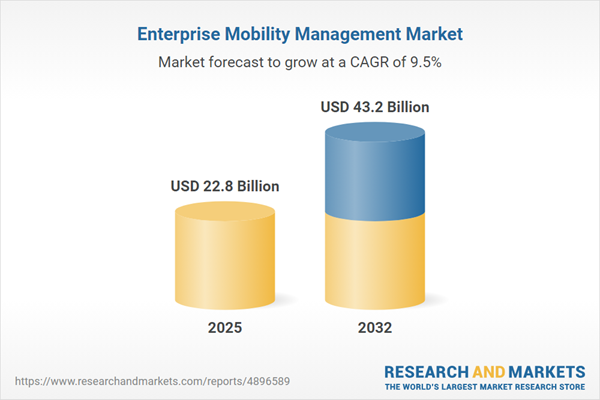Speak directly to the analyst to clarify any post sales queries you may have.
Enterprise mobility management enables organizations to safeguard data and empower their workforce in complex digital environments. Senior decision-makers must monitor the interplay between technological advances and workforce expectations to optimize business agility and manage risk.
Market Snapshot: Enterprise Mobility Management Market Size and Growth
The Enterprise Mobility Management Market is experiencing sustained expansion, with market value growing from USD 20.84 billion in 2024 to USD 22.80 billion in 2025. A compound annual growth rate (CAGR) of 9.53% underscores strong momentum, with forecasts placing the market at USD 43.20 billion by 2032. This trajectory is influenced by climbing mobile device adoption, rising emphasis on secure endpoint management, and concerted digital transformation efforts spanning multiple sectors. Organizations are proactively addressing mobile security and productivity, further supporting the broad deployment of enterprise mobility management solutions designed to meet evolving operational needs.
Scope & Segmentation
This report thoroughly analyzes the enterprise mobility management landscape, equipping stakeholders to identify precise solutions that best match their business needs and strategic priorities. Key market segments include:
- Component: Managed and professional services, plus innovative platforms supporting Identity and Access Management (IAM), Mobile Application Management (MAM), Mobile Content Management (MCM), Mobile Device Management (MDM), and Unified Endpoint Management (UEM) for comprehensive endpoint security, compliance, and process standardization.
- Operating System: Enterprise mobility management solutions are tailored for diverse environments, managing devices operating on Android, iOS, Linux, macOS, and Windows, addressing the need for consistent security across varied technology ecosystems.
- Deployment Model: Options span cloud, private cloud, public cloud, and on-premises, providing organizations with critical flexibility for infrastructure scaling, security control, and regulatory compliance.
- Industry Vertical: The report examines use cases and requirements in sectors such as Banking Financial Services and Insurance; Government and Defense; Healthcare and Life Sciences; IT and Telecom; Manufacturing; and Retail and Consumer Goods, reflecting the distinct regulatory and operational challenges each faces.
- Organization Size: Solutions are mapped to the unique needs of both large enterprises and small and medium enterprises (SMEs), with scalable controls and administration aligned to company size.
- Region: Market coverage includes the Americas (with specifics on North America and Latin America), Europe, Middle East & Africa, and Asia-Pacific, highlighting differences in regulatory conditions and mobile technology adoption.
- Companies Covered: The analysis profiles influential market vendors, such as Microsoft Corporation, VMware, Inc., International Business Machines Corporation, Citrix Systems, Inc., Ivanti, Inc., BlackBerry Limited, Jamf, LLC, SOTI Inc., Cisco Systems, Inc., and Zoho Corporation, enabling comparison of strategies, capabilities, and compliance readiness.
Key Takeaways for Senior Decision-Makers
- Enterprise mobility management now extends beyond device oversight, serving as a central enabler for enterprise productivity and operational integrity across digital workforces.
- Adoption of integrated management frameworks supports seamless user experiences and robust security, combining identity governance, application lifecycle management, and coordinated device oversight.
- Organizations increasingly utilize advanced cloud solutions, analytics, and artificial intelligence to proactively respond to security challenges and enhance mobile operations.
- Differentiated regulatory needs and diverse infrastructure levels across regions drive the demand for tailored enterprise mobility management deployments and local compliance controls.
- Strategic vendor partnerships and comprehensive solution portfolios provide the agility needed for hybrid deployments and fluid regulatory environments.
- Vertical-specific expertise and onboarding processes, especially in finance, healthcare, and government, are critical as compliance expectations continue to expand.
Impact of Tariff Policies on Procurement Strategies
Recent U.S. tariff policies have influenced procurement, leading to increased complexity and cost sensitivity for enterprises acquiring mobile devices and supporting infrastructure. In response, organizations are revising supply chain models, pursuing broader sourcing diversification, and shifting toward flexible, consumption-based pricing and modular deployments. These changes require agile procurement planning, robust inventory management, and alignment of sourcing strategies to maintain resilience amid an evolving global landscape.
Methodology & Data Sources
This report synthesizes insights from interviews with IT leaders, mobility architects, and security professionals, validated against secondary research from recognized industry and compliance sources. A triangulation-based validation process is applied to ensure accuracy and objectivity.
Why This Report Matters for Enterprise Mobility Management
- Assists senior leaders in vendor selection and investment, connecting mobility objectives with future-proof technology strategies tailored for the enterprise mobility management market.
- Clarifies interactions of compliance demands and technology, helping manage risks across complex global and industry environments.
- Guides adaptation as markets and technologies shift, enabling balanced decision-making around security, efficiency, and user experience.
Conclusion
This report delivers strategic guidance for mobility planning, supporting leaders in crafting resilient, responsive enterprise mobility management strategies that adapt to both emerging trends and persistent challenges worldwide.
Additional Product Information:
- Purchase of this report includes 1 year online access with quarterly updates.
- This report can be updated on request. Please contact our Customer Experience team using the Ask a Question widget on our website.
Table of Contents
3. Executive Summary
4. Market Overview
7. Cumulative Impact of Artificial Intelligence 2025
List of Figures
Samples

LOADING...
Companies Mentioned
The key companies profiled in this Enterprise Mobility Management market report include:- Microsoft Corporation
- VMware, Inc.
- International Business Machines Corporation
- Citrix Systems, Inc.
- Ivanti, Inc.
- BlackBerry Limited
- Jamf, LLC
- SOTI Inc.
- Cisco Systems, Inc.
- Zoho Corporation
Table Information
| Report Attribute | Details |
|---|---|
| No. of Pages | 188 |
| Published | October 2025 |
| Forecast Period | 2025 - 2032 |
| Estimated Market Value ( USD | $ 22.8 Billion |
| Forecasted Market Value ( USD | $ 43.2 Billion |
| Compound Annual Growth Rate | 9.5% |
| Regions Covered | Global |
| No. of Companies Mentioned | 11 |









